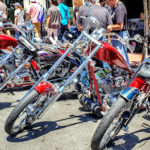Custom Chopper Builder
Custom Chopper Builder – Tom Fugle
From Wikipedia, the free encyclopedia:
The first choppers were built in America, and were an outgrowth of the milder customization trend that had originated after WW2 when returning soldiers and others began modifying cars and motorcycles, frequently to improve performance in top-speed races on dry lake beds in Southern California and similar desolate spaces such as unused airstrips in other parts of the country, or on the street for street racing. These early modified motorcycles were known as “bobbers”, and there are many common features between bobbers and choppers, with choppers differentiated being more radically modified, and especially by having the frame tubes and geometry modified (“chopped” by welding) to make the bike longer.
 The earliest choppers tended to be based on Harley-Davidson motorcycles, at first making use of the Flathead, Knucklehead and Panhead engines – many of which could be found in surplus military and police motorcycles bought cheaply at auction. As new engines became available they were soon utilized in choppers. British bikes, particularly Triumphs, were also a popular motor for choppers early on. As the Japanese manufacturers began offering larger engines in the late 1960s these motors were also quickly put to use by chopper builders. The Honda 750-4 was the most widely used Japanese motor for chopper builders early on. Choppers have been created using almost every available engine, but builders have always shown a preference for older air cooled designs. It is rare to see a chopper with a radiator.
The earliest choppers tended to be based on Harley-Davidson motorcycles, at first making use of the Flathead, Knucklehead and Panhead engines – many of which could be found in surplus military and police motorcycles bought cheaply at auction. As new engines became available they were soon utilized in choppers. British bikes, particularly Triumphs, were also a popular motor for choppers early on. As the Japanese manufacturers began offering larger engines in the late 1960s these motors were also quickly put to use by chopper builders. The Honda 750-4 was the most widely used Japanese motor for chopper builders early on. Choppers have been created using almost every available engine, but builders have always shown a preference for older air cooled designs. It is rare to see a chopper with a radiator.
Over time the choppers became more and more about achieving a certain look, rather than being primarily performance oriented modifications. The modifications that had had their origin in hotrodding evolved into an artistic and aesthetic direction. By the mid 1970s stock Japanese and European performance motorcycles would outperform most bobbers and choppers. The one exception to this was the drag racing arena, which placed a premium on pure engine power, rather than handling over curvy courses. Chopper styling continued to be influenced by drag-bike modifications throughout the 1960s and 1970s.
While all choppers are highly customized bikes, sometimes even being built from scratch using all custom parts, not all customized bikes are choppers. In Europe at roughly the same era that choppers were invented and popularized in the USA, bikers modified their bikes (primarily English brands like Triumph, BSA, Norton and Matchless) in a different way, to achieve different looks, performance goals and riding position. The resulting bikes are known as café racers, and look very different from a chopper.
As the popularity of choppers grew, in part through exposure in movies such as the 1969 classic Easy Rider, several motorcycle brands took note and began to include chopper influenced styling in their factory offerings. None of the factories were willing to go all out and do things like abandon rear-suspension to achieve the classic chopper look, however. As a result, these bikes were given the name “factory customs” and are not considered choppers.
Over the decades since the first choppers were created many different trends and fads have taken hold and held sway, so that that it is often possible for someone to look at a chopper and say that it’s a “1970s” style or fits into a specific era or sub-type. Currently some builders specialize in building choppers that very exactly fit into these styles, they are frequently referred to as “old school” style choppers.




















